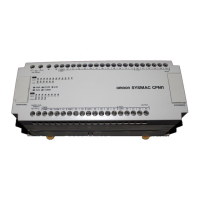Glossary
507
store The process of recording a program written into a display buffer permanently in
memory.
subroutine A group of instructions placed separate from the main program and executed
only when called from the main program or activated by an interrupt.
subroutine number A definer used to identify the subroutine that a subroutine call or interrupt acti-
vates.
subtract count input An input signal used to decrement a counter when the signal changes from OFF
to ON.
SV See set value.
switching capacity The maximum voltage/current that a relay can safely switch on and off.
synchronous execution Execution of programs and servicing operations in which program execution and
servicing are synchronized so that all servicing operations are executed each
time the programs are executed.
syntax The form of a program statement (as opposed to its meaning).
syntax error An error in the way in which a program is written. Syntax errors can include
`spelling’ mistakes (i.e., a function code that does not exist), mistakes in speci-
fying operands within acceptable parameters (e.g., specifying read-only bits as
a destination), and mistakes in actual application of instructions (e.g., a call to a
subroutine that does not exist).
SYSMAC Support Software A software package installed on a IBM PC/AT or compatible computer to func-
tion as a Programming Device.
system configuration The arrangement in which Units in a System are connected. This term refers to
the conceptual arrangement and wiring together of all the devices needed to
comprise the System.
system error An error generated by the system, as opposed to one resulting from execution
of an instruction designed to generate an error.
system error message An error message generated by the system, as opposed to one resulting from
execution of an instruction designed to generate a message.
system setup Operating environment settings for a Programming Device, e.g., the LSS or
SSS.
terminal instruction An instruction placed on the right side of a ladder diagram that uses the final ex-
ecution conditions of an instruction line.
timer A location in memory accessed through a TIM/CNT bit and used to time down
from the timer’s set value. Timers are turned ON and reset according to their ex-
ecution conditions.
TR area A data area used to store execution conditions so that they can be reloaded later
for use with other instructions.
TR bit A bit in the TR area.
trace An operation whereby the program is executed and the resulting data is stored
to enable step-by-step analysis and debugging.
trace memory A memory area used to store the results of trace operations.
transfer The process of moving data from one location to another within the PC, or be-
tween the PC and external devices. When data is transferred, generally a copy

